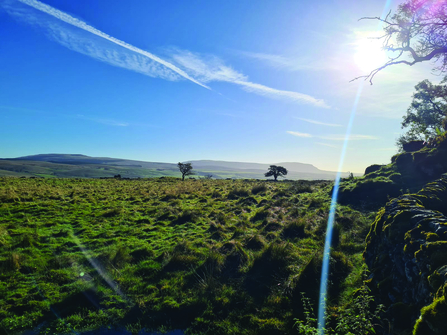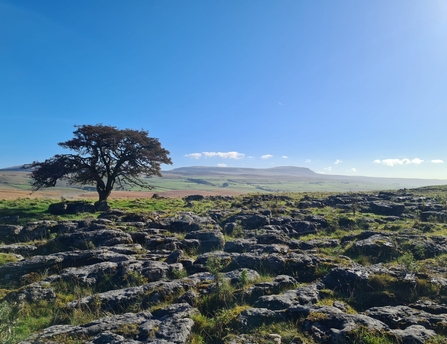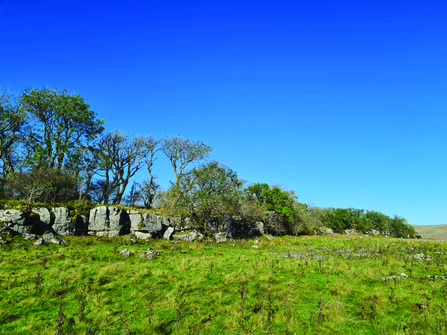Ashes Shaw provides a vital link for wildlife, which will help cope with the climate crisis and adds to our suite of nature reserves in this celebrated area of the Yorkshire Dales. Here’s why it is important:
Connecting Ingleborough Mountain

Climate Crisis
In response to climate change, some species of plants and animals adapt by shifting their ranges latitudinally or altitudinally. This happens at an individual level, either by actual movements or more gradually, as individuals at the more inhospitable edge of the range die out and individuals at the more habitable edge prosper. Over time, this shifts the range of a population.
These range changes can be in terms of latitude; species in the UK are tending to move north and west to cooler, wetter climes, away from the south and east where conditions are warming and drying. In turn, species from the south are colonising the UK.
The changes can also cause species to shift ‘uphill’, as conditions at higher altitudes can often be cooler and wetter too; for every 1000m of altitude, the temperature decreases by 6.5 degrees Celsius.

Reconnecting our landscape
One of the driving forces behind our Wild Ingleborough project, is to reconnect the landscape, either through land purchase or by working with our neighbours to encourage them to look after their land in a way that is beneficial to wildlife.
This means that with larger areas, wildlife populations are larger and, therefore, more robust. Also, by reconnecting patches of habitat on the mountainside, species have an opportunity to shift their ranges uphill as environmental conditions change.

Our team celebrating the purchase of Ashes Shaw.
Land purchase
In September, we were delighted to complete the purchase of Ashes Shaw, a large area of grassland (18 hectares/44 acres) and limestone pavement, which links together our nature reserves lower down the slope or Ingleborough, at Ashes Pasture and Bellfield’s Pasture with the National Nature Reserve.
This missing link establishes a vital connection, meaning that from the river Ribble in the valley bottom all the way up to Simon Fell, is in continuous conservation management, an altitudinal difference of about 300 metres. This means that wildlife will have the chance to expand populations across larger areas of the mountain, and shift ranges to more suitable conditions as the climate changes.

Our vision for Ashes Shaw and Wild Ingleborough
Ashes Shaw is currently in a Countryside Stewardship scheme and the Trust will continue to deliver this until the end of next year. Very soon, the previous owner’s sheep will be taken away to market and from then, the site will be managed by light cattle grazing. This will enable wildflowers and grasses typical of the limestone grasslands of the National Nature Reserve to flourish.
The band of exposed limestone pavement will, with time, start to ‘scrub up’, as bushes and small trees establish; the woodland of Colt Park on the western edge of Ashes Shaw will gradually creep out, creating a softer boundary. A wider variety of plants should attract more insects, including butterflies like the small pearl-bordered fritillary and northern brown argus, which will colonise from nearby areas. With thriving populations of insects, birds such as cuckoos, wheatears and redstarts should thrive. We hope to establish patches of trees meandering up the slope, connecting woodlands at Ashes Pasture across Bellfield’s Pasture to Colt Park, to enable woodland birds and insects and small mammals, such as red squirrels, to move more easily in the landscape.
Ashes Shaw has some very significant archaeology, part of which is protected as a Scheduled Ancient Monument. Many of the features, including livestock enclosures and a round house are thought to be Iron Age, whilst some sheep folds and hut walls may be Medieval. We are working closely with local Landscape Archaeologist, David Johnson to ensure that our plans do not damage or interfere with any of these features and will seek to provide information to visitors about the history of the site.
This is our vision for Ashes Shaw and Wild Ingleborough, but with any restoration, time is needed to realise these ambitions. During 2023, we will improve the access so that visitors can enter Ashes Shaw and enjoy the wildlife and the stunning views down Ribblesdale to Pen-y-Ghent Mountain. The access will be basic – a gate and a sign – but even if you just look over the wall, you will see how we are beginning to restore the habitats, connect the mountain and bring a bit of ‘wild’ back to the landscape.
The purchase of Ashes Shaw is the third piece of land acquired by the Trust in the area since the launch of Wild Ingleborough in spring 2021. We would like to express our sincere thanks to the funders of Wild Ingleborough who have made this purchase possible.

